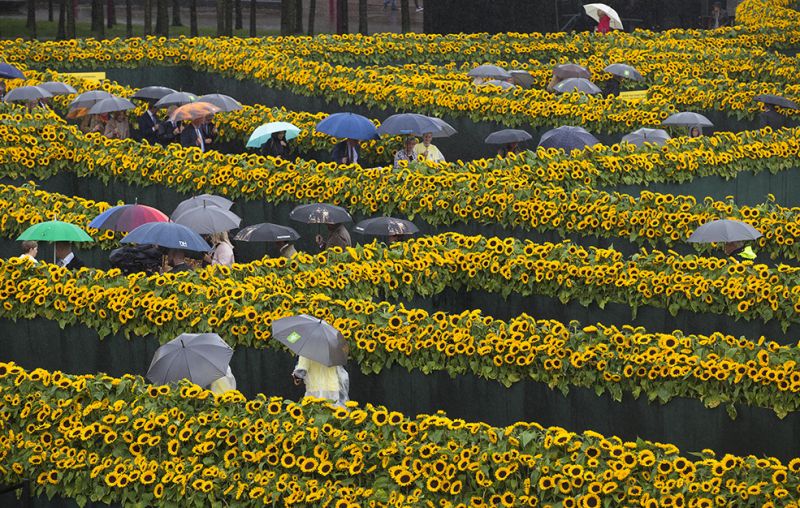by Ken Lain, the mountain gardener
This week’s garden photo is taken in Amsterdam at the entrance of the Van Gogh museum, commemorating the 125th anniversary of the Dutch master’s death. Guests take cover from the rain as they walk through a labyrinth of 125,000 sunflowers. (AP Photo/Peter Dejong)

Aren’t sunflowers an uplifting element in the garden? There are a lot of benefits to growing sunflowers. Not only are sunflowers big, bold, and beautiful, but they also attract beneficial insects, birds, and other wildlife to the garden. The autumn bonus of growing sunflowers is the harvest of the seed heads and roasting the seeds. Kids love this project, especially harvesting the seed heads, popping out the seeds, and roasting the healthiest of snacks. This is a great project for kids groups like 4H, Girl and Boy Scouts, and school garden clubs. While all sunflowers are beautiful and attract wildlife, usually the best sunflower heads to use are those produced by the bigger sunflowers like Giant Gray Stripe, Sunzilla, and Mammoth.
Cut the flower heads off the stalks, let the heads dry until the front of the heads turn a crispy brown and the back of the heads are on the yellow side. At this stage the seeds are ready to be popped from their flowers. Lay them flat on a covered table and let the kids rub the front of the sunflower heads. The seeds will pop out easily and young kids will be quite entertained. Carefully sort through the seed piles to pick out undesirable pieces of stem and flower.
Dissolve 1/2 cup of table salt in ½ gallon of water, add the sunflower seeds and soak them overnight. If you don’t have all night to wait for the seeds to flavor, simmer the salt, water, and seed for 2 hours on the stove. If you’d rather have unsalted seeds, skip this section and go straight to roasting.
Drain the salt water from the seeds and lightly dry them with a paper towel. Preheat the oven to 300 degrees. Spread the seeds on a large cookie sheet and let them roast 30-40 minutes in the oven. Best to give ‘em a quick stir after 20 minutes of baking for an even bake on all sides. Seeds are ready to eat when they turn brown and look crisp, or you can pull them out when they just look dry. Pull seeds from the oven and let them cool.
 The finished product is a matter of individual taste, so you may want to experiment with a few batches until you get them flavored just right. Butter on sunflower seeds is much like butter on popcorn . . .delicious! Taste them and flavor to your liking; sometimes a bit of flavored sea salt adds to the flavor. To keep sunflower seeds, once they’ve cooled store them in a tightly sealed container.
The finished product is a matter of individual taste, so you may want to experiment with a few batches until you get them flavored just right. Butter on sunflower seeds is much like butter on popcorn . . .delicious! Taste them and flavor to your liking; sometimes a bit of flavored sea salt adds to the flavor. To keep sunflower seeds, once they’ve cooled store them in a tightly sealed container.
Serve them at your next garden party and guests will be wowed that you grew, harvested, and roasted your own sunflower seeds.
Insider’s tip for Granddads. I teach my grandsons how to spit sunflower seed for distance. There is definite bonding of the generations when ‘Pops’ teaches them something so cool. Of course, this has met with only mild amusement from their grandmother, YaYa, and their mom, my daughter-in-law. Dissenters aside, we all know it’s a good memory we share between the generations.
Until next issue, I’ll see you at the garden center.
Ken Lain can be found throughout the week at Watters Garden Center, 1815 W. Iron Springs Rd in Prescott, or contacted through his web site at

